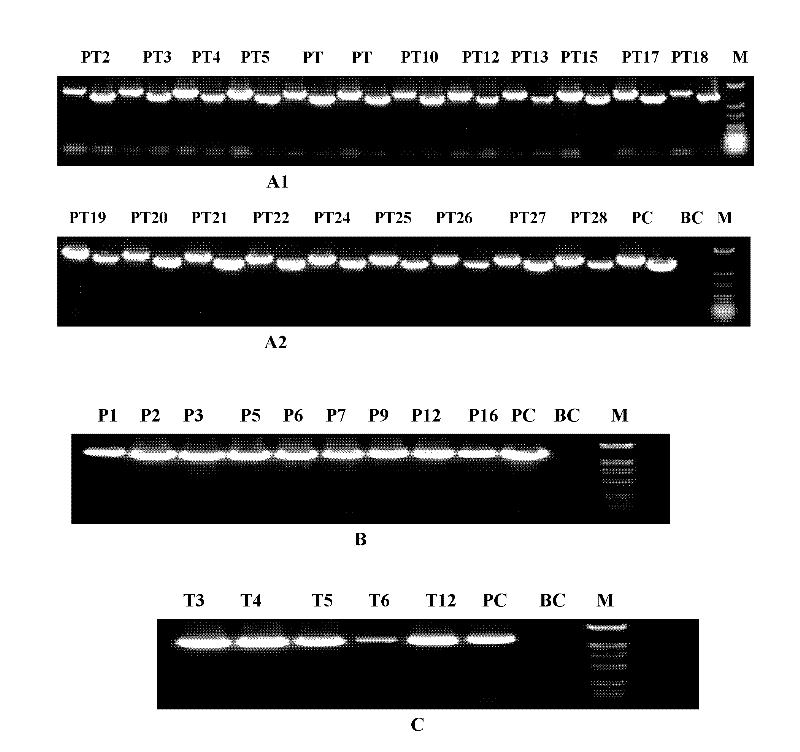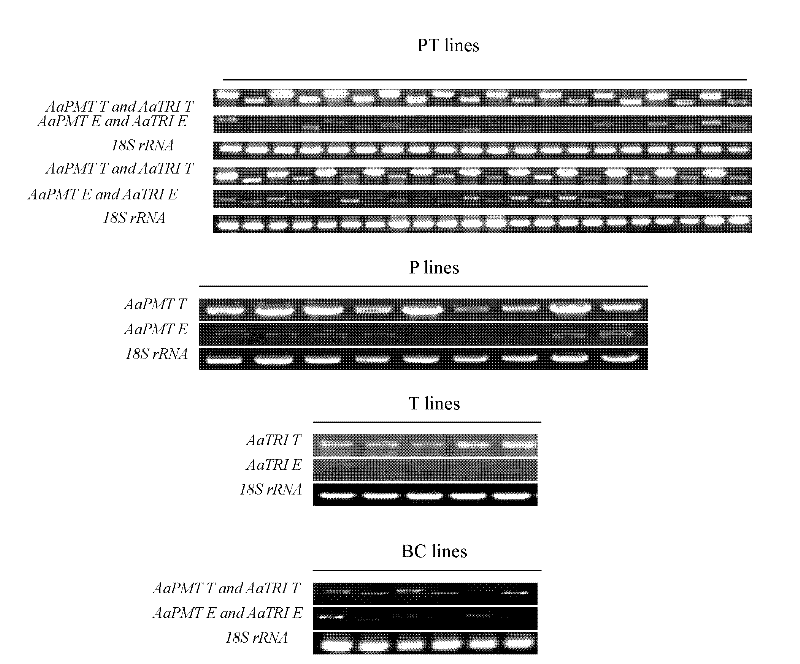Method for carrying out cotransformation on double genes of AaPMT and AaTRI to improve content of tropine alkaloid in anisodus acutangulus hairy roots
A co-transformation and alkaloid technology, applied in the field of bioengineering, can solve the shortage of wild resources and other problems, and achieve the effect of alleviating the shortage problem
- Summary
- Abstract
- Description
- Claims
- Application Information
AI Technical Summary
Problems solved by technology
Method used
Image
Examples
Embodiment 1
[0037] 1.1. Extraction of total RNA from three-point hairy root and synthesis of cDNA first strand
[0038] The RNA prep pure plant kit provided by TIANGEN was used to extract total RNA from the three-point transgenic hairy roots (refer to the instructions in the kit for the extraction steps). The fresh weight of the three-thirds transgenic hairy root used to extract total RNA is about 0.1g-0.15g, and the DNA in the sample has been removed with DNase working solution during the extraction process. Measure the relative absorbance value of the extracted RNA on a spectrophotometer, and calculate the purity and concentration of the extracted RNA. Finally, 1 μg of RNA was used as the initial amount for each sample, and the first-strand cDNA was synthesized with reverse transcriptase XL (AMV) (for the operation steps, refer to the relevant instructions provided by Promega).
[0039] 1.2. Design of AaPMT and AaTRI coding sequence-specific primers and acquisition of target gene fragm...
Embodiment 2
[0045] Example 2 Construction of plant expression vectors containing three-thirds AaPMT and / or AaTRI genes
[0046] 2.1. Intermediate vector pCAMBIA1304 + build (see figure 1 )
[0047] Using pBI121 and pCAMBIA1304 as materials, construct the plant expression vector pCAMBIA1304 + . Specifically, pBI121 and pCAMBIA1304 were digested with HindIII / EcoRI; the pBI121-GUS expression cassette and the large pCAMBIA1304 fragment were recovered; ligation transformation was carried out, and single-clonal colonies were picked to extract plasmids for digestion verification. The results showed that the plant expression vector pCAMBIA1304 + The build was successful. like figure 1 shown.
[0048] 2.2. Plant expression vector pCAMBIA1304 + - Construction of AaPMT
[0049] The successful pCAMBIA1304 constructed above + Basically, replace the GFP+GUS gene with the AaPMT gene cloned from Sanfensan. Specifically, BglII / BstEII double enzyme cut pMD18T-AaPMT and pCAMBIA1304 + ; Recover A...
Embodiment 3
[0054] Example 3 Agrobacterium rhizogenes mediates the genetic transformation of AaPMT and AaTRI genes to obtain three-thirds of transgenic hairy roots
[0055] 3.1. Containing plant expression vector pCAMBIA1304 + -Acquisition of AaPMT-AaTRI Agrobacterium rhizogenes engineering bacteria
[0056] The plant bivalent expression vector body pCAMBIA1304 containing AaPMT and AaTRI gene in embodiment 2 + -AaPMT-AaTRI was transformed into Agrobacterium rhizogenes C58C1, and a single clone colony was picked for PCR verification. The results showed that the plant expression vector containing AaPMT and AaTRI genes had been successfully constructed in Agrobacterium rhizogenes strain C58C1.
[0057] 3.2. Agrobacterium rhizogenes mediates genetic transformation of AaPMT and AaTRI genes
[0058] 3.2.1. Preculture of explants
[0059] Three-thirds sterile seedling leaves (1cm×1cm) and stems (1cm) explants were cut and cultured on MS solid medium (the medium was in a transparent plastic c...
PUM
 Login to View More
Login to View More Abstract
Description
Claims
Application Information
 Login to View More
Login to View More - R&D Engineer
- R&D Manager
- IP Professional
- Industry Leading Data Capabilities
- Powerful AI technology
- Patent DNA Extraction
Browse by: Latest US Patents, China's latest patents, Technical Efficacy Thesaurus, Application Domain, Technology Topic, Popular Technical Reports.
© 2024 PatSnap. All rights reserved.Legal|Privacy policy|Modern Slavery Act Transparency Statement|Sitemap|About US| Contact US: help@patsnap.com










